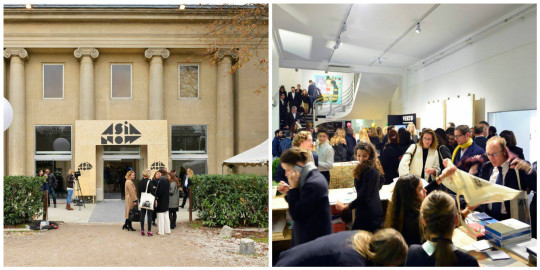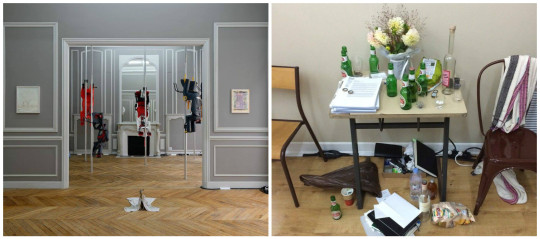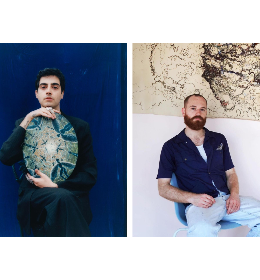From the carpeted aisles of the Regent’s Park tents, to the glass roofs of the Grand Palais, all of the predictable pieces were indeed present. The complex machinery of these fairs is organized by Matthew Slotover and Amanda Sharp in London, and Reed Expo in Paris, both of whom have seen success with 60,000 and 70,000 visitors respectively, which includes a few hundred buyers and investors who keep the projects in existence and keep the dealers happy. White Cube exceeded the million dollar turnover just hours after the opening of the FIAC, with sales of works of Adnan, Georg Baselitz and Mona Hatoum … Were art lovers the only ones disappointed?
The contemporary art audience is generally snobbishly critical and grumpy by nature and yet still insist on being surprised.
What went there ?
In London, as has become tradition, Helly Nahmad had the most noticeable stand. The only one breaking out of the “white cube” mold, it was staged as an asylum from the ‘30s. The scene carefully set by Robin Brown certainly had an effect, even if it was more to do with the soundtrack of Edith Piaf and Sleeping Beauty than an appreciation of the Dubuffet pieces on display. At least three of the eight Dubuffet works were sold for between $650,000 and $3.5 million. During their Paris appearance, the gallery sold a Modigliani for millions, of course.
Elsewhere in London, Kamel Mennour sold the majority of works from its solo show dedicated to Camille Henrot, including 8 works from the series Retreat From Investment (€150,000 each); the artist also made a splash at Koning Gallery, with ceramics going for €45,000. For other sales, sculptures by Conrad Shawcross, went for £30,000 to £70,000 at Victoria Miro; an LED sculpture by Jenny Holzer, All Fall (2012) at Sprüth Magers for which an American collection spent $500,000; Propoganda (1975-78) by Mario Schifano at Eykyn Maclean went for around $750,000, and Rosso Plastica (1966) by Alberto Burri at Mazzoleni sold for close to €2 million… just in case you were worried, all is well in the art world.
At FIAC, highlight sales include five bronze works by Georg Baselitz at Thaddaeus Ropac for €750,000 each. The gallery also sold a sculpture by Antony Gormley for £375,000. Lehmann Maupin saw photos by Alex Prager sell for between $40,000 and $70,000. Whilst George Condo was in the spotlight this year with at least two works sold, by Skarstedt and Sprüth Magers, for $600,000 apiece.

The diversification of Paris’s satellite fairs seems to have impressed many. Whilst Asia Now fills an obvious gap in the market, Paris Internationale caters for an oft-excluded audience. Internationale is the hip ‘fuck you’ to conventional art fairs, founded by five young French galleries and housed in a disused hotel particulier a stone’s throw from the Palais de Tokyo. Participants aren’t paying rental fees to an overarching agency as the founding galleries invested from their own pockets to make the necessary adjustments to the space. Housing 34 galleries and 7 not-for-profits, organizers Antoine Levi, Galerie Crèvecoeur, Gregor Staiger, High Art, and Sultana hashed together the entire presentation in three months which featured provocative performances and a talks programme led by Berlin-based Spike magazine.

Paris Internationale, High Art's booth (on the left)
Participating galleries pay a €4,000 check, compared to the steep €12,000 for the much less convincing (OFF)icielle.
Accessible prices impressed not only a younger crowd alienated from mega-fairs, but also collectors. One Mexican collector said “I have been attending FIAC for years, it is a beautiful fair but I want to see something fresh, and quite frankly, prices at FIAC have become ridiculous.” Fresh and affordable is exactly what you will find at Internationale.
Concerning sales, Artsy specifies that Steve Pulimood’s gallery, Room East, sold two works by Dario Guccio (between €3,500 and €5,500) to a Belgian collector. Another result was by Stroganova gallery, who sold five photographs by Martin Soto Climent. The black-and-white works see various materials folded suggestively. Three smaller works went for $2,500 apiece and two larger pieces for $10,000 each.
And what did we really think ?
In London, Masters remains a safe bet for both investment and aesthetics. We saw West Asia ramp up new collectors and benefactors. The Samdanis and their foundation were originally noticed at the Dhaka Art Summit. They are poised to succeed in less than five years where no other foundation in the region has dared to venture. Furthermore, Haroon Mirza, whose sculptures are both beautiful and entertaining, has just won the Calder prize and is taking to Dhaka for a solo project.
In Paris, Chantal Crousel presented a formidable stand with David Douard, Mona Hatoum, Heimo Zobernig, Rirkrit Tiravanija, whilst the Marcel Duchamp prize saw with Melik Ohanian take gold.
In London, as in Paris, you had to take the back aisles to uncover the real gems: Clearing; Peres Projects; Jacqueline Martins; Third Line; Casas Riegner; Jousse and Rodeo, noticed in Basel, pulled out all the stops in London and Paris. In Paris, gb agency in the corner surprised us with works by Omer Fast, who is also currently at the Jeu de Paume.
If Victoria Siddall was criticized for spotlighting an eggplant, and some were disappointed by the lack of attention accorded to the Parisian scene at the Grand Palais, today’s fairs cater much less to art lovers than to investors. The first can best assist the latter not to lose their way. Hopefully we won’t tire of this rationalization, as in the short term it is not only fruitless artistically, but also financially.
Photo : via Facebook









